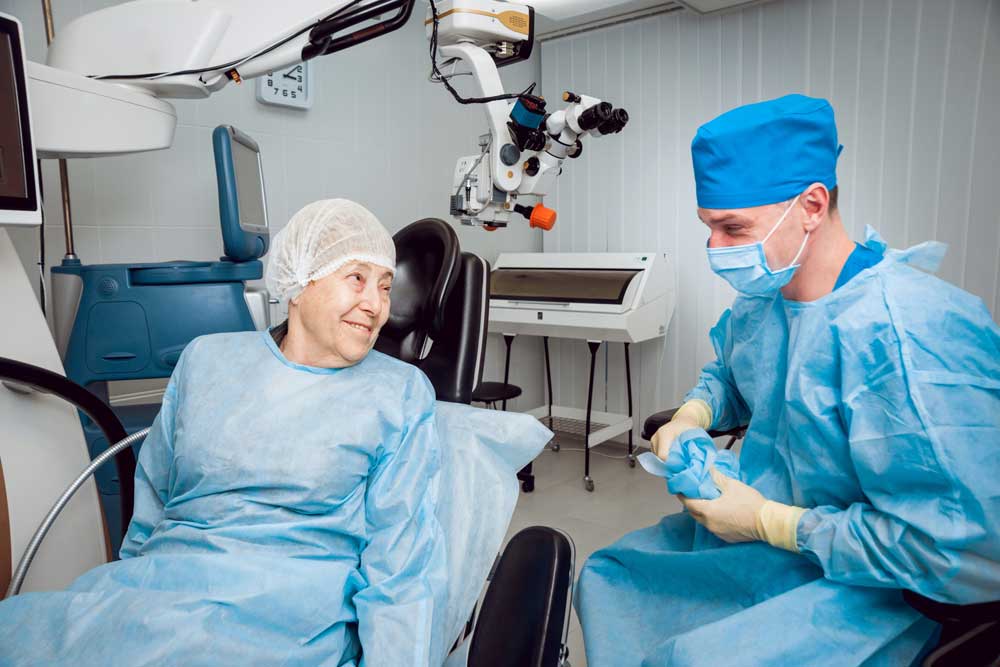Myth: Is Cataract Surgery Painful? Exploring the Procedure and Recovery Process
Posted by: Ophthalmology Associates of Fort Worth in Uncategorized

Our sense of sight is one of the direct ways we experience the world around us. But as you age, you can lose this sense because of cataracts, impairing your vision and affecting your quality of life.
But thanks to cataract surgery, restoring your vision and witnessing life in vivid detail is possible.

However, there’s a prevalent concern about the pain involved in the procedure. So, in this article, we aim to dispel the myths, address your worries, and provide a realistic understanding of what to expect during and after cataract surgery.
Understanding Cataracts
Cataracts are a common eye condition that affects more than 24 million Americans aged 40 and up.
The condition affects the lens, a clear, flexible structure that helps to focus light onto the retina, which is the light-sensitive tissue at the back of the eye. You get a cloudy lens in a cataract, making it difficult to see clearly.
Over time, these patches usually become bigger, worsening your vision problem and eventually leading to blindness without laser cataract surgery.
Although they can affect people of any age, cataracts are most common in older adults because of the natural aging process. Other risk factors include but are not limited to:
- prolonged exposure to ultraviolet sunlight
- smoking
- family history of cataracts
- high blood pressure
When affected by cataracts, reading, driving a car at night, or seeing the expression on a friend’s face becomes very difficult. You can also experience double vision, sensitivity to light, and trouble seeing colors.
Fortunately, it’s treatable with a quick and generally painless cataract surgery.
How Is Cataract Surgery Performed?
Laser cataract surgery is relatively straightforward, typically lasting around 30 minutes for each eye.
An eye surgeon performs it as an outpatient procedure, which means you can go home the same day.
But before the ophthalmologist can perform cataract surgery, there needs to be some preparations made. This usually involves an eye exam and medical tests.
Once everything is in order, the eye surgery will proceed as scheduled.
During the cataract operation, the surgeon will remove the cloudy lens and insert a new one, called an intraocular lens (IOL), which is designed to focus light onto the retina.
There are a variety of lenses that can be implanted during cataract surgery, including monofocal and multifocal IOLs.
- Monofocal IOLs: provide clear vision at a distance, but reading glasses are usually needed for close work after surgery.
- Multifocal IOLs: provide clear vision at multiple distances, such as distance, near, and intermediate. This reduces the need for reading glasses.
The type implanted during refractive surgery will depend on your individual needs and the recommendation of your cataract surgeon.
As for the procedure, it’s generally the same regardless of the type of IOL to be implanted.
However, there are some differences in the recovery time and wound healing. Patients who receive monofocal IOLs typically recover more quickly than those who receive multifocal IOLs.
But because it’s a generally painless procedure, most patients report only minor discomfort, and any mild pain post-surgery can be managed with over-the-counter painkillers.
How Is Cataract Surgery Performed?
Laser cataract surgery is relatively straightforward, typically lasting around 30 minutes for each eye.
An eye surgeon performs it as an outpatient procedure, which means you can go home the same day.
But before the ophthalmologist can perform cataract surgery, there needs to be some preparations made. This usually involves an eye exam and medical tests.
Once everything is in order, the eye surgery will proceed as scheduled.
During the cataract operation, the surgeon will remove the cloudy lens and insert a new one, called an intraocular lens (IOL), which is designed to focus light onto the retina.
There are a variety of lenses that can be implanted during cataract surgery, including monofocal and multifocal IOLs.
- Monofocal IOLs: provide clear vision at a distance, but reading glasses are usually needed for close work after surgery.
- Multifocal IOLs: provide clear vision at multiple distances, such as distance, near, and intermediate. This reduces the need for reading glasses.
The type implanted during refractive surgery will depend on your individual needs and the recommendation of your cataract surgeon.
As for the procedure, it’s generally the same regardless of the type of IOL to be implanted.
However, there are some differences in the recovery time and wound healing. Patients who receive monofocal IOLs typically recover more quickly than those who receive multifocal IOLs.
But because it’s a generally painless procedure, most patients report only minor discomfort, and any mild pain post-surgery can be managed with over-the-counter painkillers.
Pre-Surgery Preparation
Like any surgery, there are a few steps you should take to prepare yourself and ensure the best possible outcome.
First and most importantly, discuss with your eye surgeon any medications you’re currently taking, as these can interfere with healing.
Other things that are recommended pre-surgery:
- Prepare your home for a comfortable recovery.
- Have a family member or friend drive you home after the surgery.
- Ensure you have all the necessary supplies, such as anti-inflammatory eye drops and sunglasses.

Surgery Procedure
- The cataract surgery process begins with the application of local anesthesia. Here, the surgeon will apply numbing eye drops to ensure you do not experience any pain during the procedure. You may also be given a mild sedative to help you relax.
- The surgeon will make a tiny incision in the cornea, the clear, dome-shaped surface that covers the front of the eye. The cloudy lens is broken into small pieces and gently removed using high-frequency ultrasound technology.
- Once the cataract has been removed, the surgeon will insert the IOL into the eye. This artificial lens is made of plastic or silicone and is designed to focus light onto the retina.
- The surgeon closes the incision with stitches or a special adhesive. This ends the whole procedure.
One common concern about cataract surgery is the use of anesthesia and its impact on the pain during cataract surgery and when the procedure is done.
It’s important to understand that anesthesia in cataract surgery is not only to numb the eye but also to minimize any discomfort and anxiety during the procedure.
Local anesthesia is generally safe and effective, and severe pain is rare. Furthermore, the risks of anesthesia are very low for cataract surgery.
After the surgery, some mild discomfort or irritation is normal for a few days. This can usually be managed with over-the-counter pain relievers and should improve as your eye heals.
Following your doctor’s instructions is critical to managing discomfort and recovery towards correct vision. While it’s rare, persistent or worsening pain should be reported immediately.

Sensations During Cataract Surgery
Cataract surgery is a painless procedure, and as your eye is under the effect of local anesthesia, you may feel some pressure that should only last a few seconds, akin to the gentle press of a finger.
Remember that this unusual sensation is normal and doesn’t signal anything wrong. Here are other sensations you may experience during the procedure:
- Numbness: Local anesthetic will cause the eye to feel numb, so you shouldn’t feel any pain.
- Pressure: The surgeon may apply pressure to keep the eye still and help remove the cloudy lens.
- Light flashes: You may see bright lights flashing, caused by the phacoemulsification machine, which breaks up the cloudy lens.
- Flickering vision: After the procedure, you may experience flickering vision because your new lens is still adjusting to your eye.
But everyone experiences cataract surgery differently. Some people may experience more sensations than others. If you have concerns about what to expect during surgery, talking to your doctor should help put you at ease.
Anesthesia and Sedation Options
Cataract surgery involves various types of anesthesia and sedation to ensure the comfort and safety of the patient.
Below are the most available options:
- Topical anesthesia: This is the most common type used for cataract surgery. It involves applying numbing eye drops to numb the surface of the eye. This type is usually sufficient for most cataract surgeries.
- Regional anesthesia: This type numbs the area around the eye. It can be injected into the eye socket or the space between the eye and the eye muscles. This type is sometimes used for cataract surgery if you aren’t comfortable with topical anesthesia or have other medical conditions that make general anesthesia more risky.
- General anesthesia: This type of anesthesia puts you to sleep during the surgery. It’s a sedative not often used for cataract surgery. Still, it may be necessary if you’re very anxious about the procedure or have other medical conditions that make regional or topical anesthesia unsafe.
The anesthesia or sedative used will depend on your individual needs and preferences. Your doctor will discuss the options and help you choose the best option.
Myth: Is Cataract Surgery Painful?
One of the most common misconceptions about cataract surgery is that it is painful. However, this is far from the truth.
It’s generally painless, thanks to the advancements in medical technology and the use of anesthesia and numbing drops.
During the procedure, you might experience pressure on your eyes. This is normal due to the instrument used to break up the lens.
During the postoperative period, it’s normal to experience discomfort or soreness in the eye. However, this is usually mild and can be managed with over-the-counter pain medications.
Remember, everyone’s experience with cataract surgery is unique. Contacting your doctor immediately is crucial if you experience persistent or worsening pain.

Post-Surgery Recovery
Timeline of Cataract Surgery Recovery
Recovery from cataract surgery typically follows a predictable timeline, but it can still vary since a patient’s journey is unique. After surgery, you may experience the following:
- Immediately after surgery, Your eyes will be covered by a patch or shield. It’s possible to have some discomfort or soreness, but this should be mild and can be managed with over-the-counter pain medication. Some mild dryness, light sensitivity, and blurred vision should also be expected.
- 1-2 days after surgery: The patch or shield will be removed, but you may still have discomfort or soreness. This should improve over time, and so will your vision.
- 1-2 weeks after surgery: You should be able to return to normal activities, but avoiding strenuous activities for about two weeks is recommended.
- 1-2 months after surgery: Full recovery is expected. Your vision should also be fully restored.
Follow-up appointments are usually scheduled soon after the procedure so your doctor can check your recovery progress. Further appointments are set after a week and a month if your eyes are healing normally.
Attending follow-up appointments is critical even when your vision has significantly improved. This ensures any complications are detected early and can be addressed promptly.
Post-Operative Discomfort: Realistic Expectations
After the procedure, it’s common for patients to experience temporary discomforts such as:
- Eye dryness and irritation: This is a common side effect since the incision in the eye can make it difficult for tears to spread evenly across the eye’s surface. This can lead to dryness and irritation. This can be managed with over-the-counter artificial tears or tear lubricants.
- Blurred vision: Another common side-effect of the new lens adjusting to the eye. Expect your vision to be blurry for a few days or weeks after surgery. This is usually temporary and will improve over time.
- Light sensitivity: The new lens can make your eyes more sensitive to light. When this happens, it’s recommended that you wear sunglasses or a hat to protect your eyes from bright environments.
- Soreness or discomfort: You may also experience some soreness or discomfort in the eye after surgery. This is usually mild and can be managed with over-the-counter pain medication.
Remember that these are all normal side effects of the cataract procedure and are part of the healing process. They should subside within a few days.
Over-the-counter pain medications and eye drops should suffice in managing these symptoms. If these discomforts persist or worsen, contact your doctor immediately.
Managing Discomfort During Recovery
Properly managing discomfort as you recover from eye surgery is key to speeding up your healing process as you continue your daily activities. Here are some practical tips to consider:
- Follow your doctor’s instructions: This is the most crucial step. Make sure you understand all your doctor’s instructions and follow them religiously.
- Use over-the-counter pain medications: Oral painkillers can be very effective for mild discomfort and soreness.
- Cold compresses: This can help reduce any swelling and discomfort. Make sure to wrap the cold pack in a soft cloth to avoid direct contact with the eye.
- Avoid straining your eyes: Avoid activities that strain your eyes, such as reading, watching TV, or using a computer for long periods. Resting your eyes often to aid recovery.
- Wear sunglasses: Always wear sunglasses outside or in a brightly lit room. Doing so can help manage light sensitivity after surgery.
- Do not rub your eyes: This can cause irritation and extend your recovery time. Use the prescribed eye drops or artificial tears instead if you feel an itch or discomfort.
- Stay hydrated and maintain a healthy diet: Staying hydrated and eating a balanced diet can aid your recovery. Foods rich in omega-3 fatty acids, like fish, can help reduce dryness and inflammation.
Aside from these tips, you should also understand that your recovery process and timeline can differ from that of another patient. So, be realistic with your progress and work with your doctor to ensure no complications during the healing process.
The Bottom Line: Does Cataract Surgery Hurt?
Cataract surgery is designed with a patient’s comfort as the top priority.
With modern technology and anesthesia, the operation is typically pain-free, with only mild discomfort or a sensation of pressure experienced by some patients.
At the end of the day, the best source of advice is your own doctor. You’ll get guidance based on your specific situation, and can put you at ease before, during, and after the operation.
If you’re considering cataract surgery, contact Ophthalmology Associates for more information.
Don’t let fear hold you back—cataract surgery could be the life-changing step towards clearer vision you’ve been waiting for.
